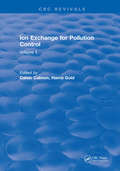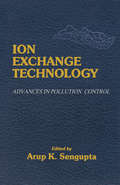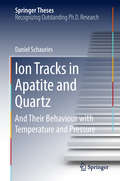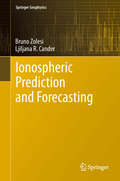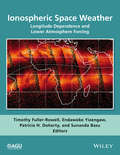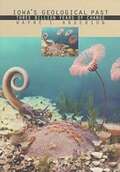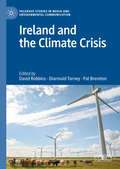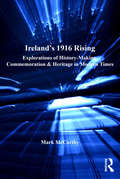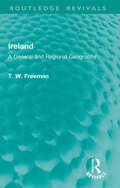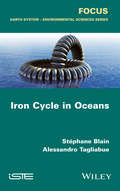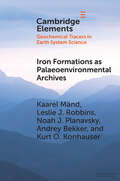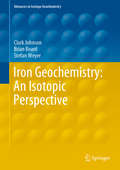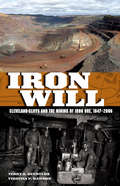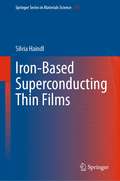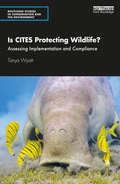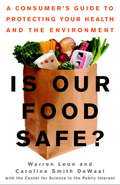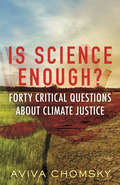- Table View
- List View
Ion Exchange Pollution Control: Volume II
by C. CalmonThe aim of these volumes is not to cover all phases of ion-exchange theory, which may be found in general texts, nor to cover every application in the literature, or to show an engineer ways on how to become an expert in the field so he coulddo it all by himself. The main purpose of these books is to show the practical engineer what has been done in various types of applications of ion-exchange processes in pollution control, how to set up laboratory tests, the problems that may be encountered to identify the individuals and organizations who are experts in the various phases of ion exchange, and most importantly, to emphasize the new developments in the polymers with active sites that offer new approaches to wastewater treatment methods.
Ion Exchange Technology: Advances in Pollution Control
by Arup K. SenGuptaThis book provides comprehensive coverage of developments in ion exchange areas which would continue to have major impacts in the general pursuit of pollution control and pollution prevention. Its nine chapters can be split into four different theme areas: trace contaminants removals; new materials; desalination and finally controlling gaseous pollutants. This would have value for practicing engineers, scientists and researchers who are pertaining to ion exchange technology. It would also server the needs of those trying to explore and identify new technologies in the areas of pollution control and pollution prevention.
Ion Tracks in Apatite and Quartz: And Their Behaviour With Temperature And Pressure (Springer Theses)
by Daniel SchauriesThis book pioneers a novel approach to investigate the effects of pressure on fission tracks, a geological problem that has remained unsolved for 60 years. While conventional techniques to study fission tracks were limited in precision, this book overcomes such issues by using state-of-the-art synchrotron-based x-ray scattering; a technique initially developed for applications in material science and biomedical research. The book provides an overview of the theory and application of small angle x-ray scattering (SAXS) on cylindrical ion tracks, including in-situ SAXS on ion tracks with simultaneous increases in temperature and pressure. As such it demonstrates a degree of characterisation normally not achievable with in-situ techniques. Further, it compares SAXS with small angle neutron scattering (SANS). This book has led to a range of publications and attracted the interest of the geological and material science communities. Daniel Schauries has been awarded several prizes for this research, including the Graduate Student Award of the Materials Research Society.
Ionospheric Delay Investigation and Forecasting (SpringerBriefs in Applied Sciences and Technology)
by N. A. Elmunim M. AbdullahThis book highlights ionospheric delay investigation and forecasting using GPS-TEC measurements in the equatorial region. The ionospheric delay error is the main source of error and a major concern for GPS applications as it corrupts the positioning and time transfer results. In the equatorial region, the variations of the total electron content (TEC) and the ionospheric delay are recognized to be high when compared with other regions such as mid-latitude and high latitude. The investigation and forecasting of trans-ionospheric propagation errors are essential for precise measurement and further contribute valuable information to satellite and space probe navigation, space geodesy, radio astronomy and other applications.
Ionospheric Multi-Spacecraft Analysis Tools: Approaches for Deriving Ionospheric Parameters (ISSI Scientific Report Series #17)
by Hermann Lühr Malcolm Wray DunlopThis open access book provides a comprehensive toolbox of analysis techniques for ionospheric multi-satellite missions. The immediate need for this volume was motivated by the ongoing ESA Swarm satellite mission, but the tools that are described are general and can be used for any future ionospheric multi-satellite mission with comparable instrumentation. In addition to researching the immediate plasma environment and its coupling to other regions, such a mission aims to study the Earth’s main magnetic field and its anomalies caused by core, mantle, or crustal sources. The parameters for carrying out this kind of work are examined in these chapters. Besides currents, electric fields, and plasma convection, these parameters include ionospheric conductance, Joule heating, neutral gas densities, and neutral winds.
Ionospheric Prediction and Forecasting
by Bruno Zolesi Ljiljana R. CanderThis book describes how to predict and forecast the state of planet Earth's ionosphere under quiet and disturbed conditions in terms of dynamical processes in the weakly ionized plasma media of the upper atmosphere and their relation to available modern measurements and modelling techniques. It explains the close relationship between the state of the media and the radio wave propagation conditions via this media. The prediction and forecasting algorithms, methods and models are oriented towards providing a practical approach to ionospherically dependent systems design and engineering. Proper understanding of the ionosphere is of fundamental practical importance because it is an essential part of telecommunication and navigation systems that use the ionosphere to function or would function much better in its nonappearance on the Earth and on any planet with an atmosphere.
Ionospheric Space Weather: Longitude Dependence and Lower Atmosphere Forcing
by Endawoke Yizengaw Patricia H. Doherty Sunanda Basu Timothy Fuller-RowellThis monograph is the outcome of an American Geophysical Union Chapman Conference on longitude and hemispheric dependence of ionospheric space weather, including the impact of waves propagating from the lower atmosphere. The Chapman Conference was held in Africa as a means of focusing attention on an extensive geographic region where observations are critically needed to address some of the fundamental questions of the physical processes driving the ionosphere locally and globally. The compilation of papers from the conference describes the physics of this system and the mechanisms that control ionospheric space weather in a combination of tutorial-like and focused articles that will be of value to the upper atmosphere scientific community in general and to ongoing global magnetosphere-ionosphere-thermosphere (MIT) modeling efforts in particular. A number of articles from each science theme describe details of the physics behind each phenomenon that help to solve the complexity of the MIT system. Because this volume is an outcome of the research presented at this first space science Chapman Conference held in Africa, it has further provided an opportunity for African scientists to communicate their research results with the international community. In addition, the meeting and this conference volume will greatly enhance the space science education and research interest in the African continent and around the world.
Iowa's Geological Past: Three Billion Years Of Change (Bur Oak Bks.)
by Wayne I. AndersonAn illustrated survey of the geological history of the state of Iowa, from the Precambrian through to the end of the Great Ice Age, written by Professor of Geology at the University of Northern Iowa.
Ireland and the Climate Crisis (Palgrave Studies in Media and Environmental Communication)
by David Robbins Pat Brereton Diarmuid TorneyThis book provides a comprehensive overview of Ireland’s response to the climate crisis. The contributions, written by leading scholars across a range of disciplines in the social sciences, humanities and beyond, shed light on diverse aspects of the climate crisis, the factors shaping Ireland’s response, and prospects for the future. Long regarded as a ‘climate laggard’, Ireland’s response to the urgent societal challenge of climate change has seen new momentum in recent times. The volume will serve as a key reference point for academics, students, policymakers, and a wide range of stakeholders. It will be of interest to readers within Ireland, as well as further afield, who wish to gain a deeper understanding of the constraints on, and opportunities for, successful climate action in Ireland.
Ireland's 1916 Rising: Explorations of History-Making, Commemoration & Heritage in Modern Times (Heritage, Culture and Identity)
by Mark McCarthyIn light of its upcoming centenary in 2016, the time seems ripe to ask: why, how and in what ways has memory of Ireland’s 1916 Rising persisted over the decades? In pursuing answers to these questions, which are not only of historical concern, but of contemporary political and cultural importance, this book breaks new ground by offering a wide-ranging exploration of the making and remembrance of the story of 1916 in modern times. It draws together the interlocking dimensions of history-making, commemoration and heritage to reveal the Rising’s undeniable influence upon modern Ireland’s evolution, both instantaneous and long-term. In addition to furnishing a history of the tumultuous events of Easter 1916, which rattled the British Empire’s foundations and enthused independence movements elsewhere, Ireland’s 1916 Rising mainly concentrates on illuminating the evolving relationship between the Irish past and present. In doing so, it unearths the far-reaching political impacts and deep-seated cultural legacies of the actions taken by the rebels, as evidenced by the most pivotal episodes in the Rising’s commemoration and the myriad varieties of heritage associated with its memory. This volume also presents a wider perspective on the ways in which conceptualisations of heritage, culture and identity in Westernised societies are shaped by continuities and changes in politics, society and economy. In a topical conclusion, the book examines the legacy of Queen Elizabeth II’s visit to the Garden of Remembrance in 2011, and looks to the Rising’s 100th anniversary by identifying the common ground that can be found in pluralist and reconciliatory approaches to remembrance.
Ireland: A General and Regional Geography (Routledge Revivals)
by T. W. FreemanAt the time of the publication of this book in its fourth edition in 1969, Ireland was alone globally in having experienced a decline of population for more than a century. National movements in Wales and Scotland made the story of the Irish Republic’s first fifty years increasingly interesting. Traditional and conservative as Ireland’s life may have seemed in the late 20th Century it had changed considerably since 1921. Like much of Western Europe it continues to share the experience of a declining number of agricultural workers and its government, like that of many other countries is concerned with the problem of industrial growth. The book analyses the physical environment and the life of 20th century Ireland whilst it was in the throes of an economic revolution.
Ireland: Contemporary perspectives on a land and its people
by R. W. Carter A. J. ParkerThis book looks at Ireland's problems from geographic and environmental perspectives, placing them within their regional, national, and international context. It is invaluable to students, decision-makers, and all those interested in the current situation in Ireland and its future.
Irish Migration, Networks and Ethnic Identities since 1750
by Enda Delaney and Donald M. MacRaildThis collection of essays demonstrates in vivid detail how a range of formal and informal networks shaped the Irish experience of emigration, settlement and the construction of ethnic identity in a variety of geographical contexts since 1750. It examines topics as diverse as the associational culture of the Orange Order in the nineteenth century to
Iron Cycle in Oceans
by Alessandro Tagliabue Stéphane BlainThis book presents an up to date view of iron biogeochemistry in the ocean. It encompasses the description of iron speciation, the analytical methods used to measure the different iron forms in seawater and the different iron biogeochemical models.
Iron Formations as Palaeoenvironmental Archives (Elements in Geochemical Tracers in Earth System Science)
by Kurt O. Konhauser Kaarel Mänd Leslie J. Robbins Noah J. Planavsky Andrey BekkerAncient iron formations - iron and silica-rich chemical sedimentary rocks that formed throughout the Precambrian eons - provide a significant part of the evidence for the modern scientific understanding of palaeoenvironmental conditions in Archaean (4.0–2.5 billion years ago) and Proterozoic (2.5–0.539 billion years ago) times. Despite controversies regarding their formation mechanisms, iron formations are a testament to the influence of the Precambrian biosphere on early ocean chemistry. As many iron formations are pure chemical sediments that reflect the composition of the waters from which they precipitated, they can also serve as nuanced geochemical archives for the study of ancient marine temperatures, redox states, and elemental cycling, if proper care is taken to understand their sedimentological context.
Iron Geochemistry: An Isotopic Perspective (Advances in Isotope Geochemistry)
by Clark Johnson Brian Beard Stefan WeyerThis book provides a comprehensive summary of research to date in the field of stable iron isotope geochemistry. Since research began in this field 20 years ago, the field has grown to become one of the major research fields in "non-traditional" stable isotope geochemistry. This book reviews all aspects of the field, from low-temperature to high-temperature processes, biological processes, and cosmochemical processes. It provides a detailed history and state-of-the art summary about analytical methods to determine Fe-isotope ratios and discusses analytical and sample prospects.
Iron Will: Cleveland-Cliffs and the Mining of Iron Ore, 1847-2006
by Virginia P. Dawson Terry S. ReynoldsThe history of Cleveland-Cliffs, a company that played a key role in iron mining development in the Lake Superior region.
Iron-Based Superconducting Thin Films (Springer Series in Materials Science #315)
by Silvia HaindlThis book provides a modern introduction to the growth, characterization, and physics of iron-based superconducting thin films. Iron pnictide and iron chalcogenide compounds have become intensively studied key materials in condensed matter physics due to their potential for high temperature superconductivity. With maximum critical temperatures of around 60 K, the new superconductors rank first after the celebrated cuprates, and the latest announcements on ultrathin films promise even more. Thin film synthesis of these superconductors began in 2008 immediately after their discovery, and this growing research area has seen remarkable progress up to the present day, especially with regard to the iron chalcogenides FeSe and FeSe1-xTex, the iron pnictide BaFe2-xCoxAs2 and iron-oxyarsenides.This essential volume provides comprehensive, state-of-the-art coverage of iron-based superconducting thin films in topical chapters with detailed information on thin film synthesis and growth, analytical film characterization, interfaces, and various aspects on physics and materials properties. Current efforts towards technological applications and functional films are outlined and discussed. The development and latest results for monolayer FeSe films are also presented. This book serves as a key reference for students, lecturers, industry engineers, and academic researchers who would like to gain an overview of this complex and growing research area.
Irons in the Fire
by John McpheeAnother of McPhee's anthologies of well-written, highly informed, and very enjoyable essays that originally appeared in the New Yorker magazine. Joihn McPhee has a talent for making any subject interesting, and the diversity of the subjects he shares with his readers just in this book is astounding - from branding cattle to mountains made of tires to forensic geology to Plymouth Rock, and more.
Is CITES Protecting Wildlife?: Assessing Implementation and Compliance (Routledge Studies in Conservation and the Environment)
by Tanya WyattThis book assesses the Convention on International Trade in Endangered Species of Wild Fauna and Flora (CITES), examining both implementation and compliance. Humans are causing a biodiversity crisis, where 1 million species are facing extinction. Species are dying, in no small part, because they are overexploited, poached and trafficked and CITES is the main international instrument designed to protect traded wildlife. Does the state of the world’s species mean CITES is failing? This book explores the implementation of and compliance with CITES by all 183 member countries. It is imperative we know the nature and extent of the implementation of and compliance with CITES legislation in all parties to fully understand the impact of legal and illegal trade on species survival. Through extensive legislative content analysis, a Delphi iterative survey, and semi-structured interviews, this is the first book to share empirical research about CITES implementation and compliance. This book contains a comprehensive analysis of the state of CITES, what is done well, what could be done better, and what the future might bring to try to curtail the slide of the world’s wildlife into extinction. By identifying lessons learned in relation to CITES legislation, implementation and compliance this book provides hard evidence to member countries as to how their own practice can be improved. This timely book will be essential reading for students and academics interested in wildlife law, trade and trafficking, green criminology and biodiversity conservation more broadly. It will also be of interest to professionals working in wildlife law enforcement.
Is It Really Green?: Everyday Eco Dilemmas Answered
by Georgina Wilson-PowellFind clarity on everyday green-living dilemmas to maximize your sustainabilityAre paper bags always more environmentally friendly than plastic? How much better for the planet are electric cars? What saves more water - using the dishwasher or washing up by hand?We all want to do the right thing for the planet, but with so many factors at play, it can be difficult to work out which is the greenest way. With answers to more than 140 everyday green-living questions, Is It Really Green? cuts through the confusion and gives you the facts.Get to the heart of each eco-conundrum, interrogate your instincts, and make informed decisions to reduce your ecological footprint.
Is Our Food Safe? A Consumer's Guide to Protecting Your Health and the Environment
by Warren Leon Caroline Smith DewaalEvery day, new warnings emerge about the safety of the food in our markets, school cafeterias, and restaurants. As industry and government officials rush in with reassurances--and food alarmists call for drastic changes in the American diet--ordinary consumers are caught in the middle. Is Our Food Safe?separates the facts from the rumors and offers straightforward, reliable advice on how to protect your health and the environment without going to extremes. Is Our Food Safe?answers common questions about the safety of meat, dairy products, fish, fruits, and other foods that make up our daily diet. It assesses the positive and negative aspects of genetically engineered foods, compares organic and conventionally produced foods, and makes recommendations about when (and if) you should choose local suppliers over industry giants. It also explains which foods to eat and which to avoid if you are concerned about clean water and air and a safe environment. Finally, it provides valuable information on how you can improve the quality of the food available in your communities, including specific issues to raise with grocers and food service providers.
Is Science Enough?: Forty Critical Questions About Climate Justice (Myths Made in America)
by Aviva ChomskyWhy social, racial, and economic justice is just as crucial as science in determining how humans can reverse climate catastrophe.We are facing a climate catastrophe. A plethora of studies describe the damage we&’ve already done, the droughts, the wildfires, the super-storms, the melting glaciers, the heat waves, and the displaced people fleeing lands that are becoming uninhabitable. Many people understand that we are facing a climate emergency, but may be fuzzy on technical, policy, and social justice aspects. In Is Science Enough?, Aviva Chomsky breaks down the concepts, terminology, and debates for activists, students, and anyone concerned about climate change. She argues that science is not enough to change course: we need put social, racial, and economic justice front and center and overhaul the global growth economy.Chomsky&’s accessible primer focuses on 5 key issues:1) Technical questions: What exactly are &“clean,&” &“renewable,&” and &“zero-emission&” energy sources? How much do different sectors (power generation, transportation, agriculture, industry, etc.) contribute to climate change? Can forests serve as a carbon sink?2) Policy questions: What is the Green New Deal? How does a cap-and-trade system work? How does the United States subsidize the fossil fuel industry?3) What can I do as an individual?: Do we need to consume less? What kinds of individual actions can make the most difference? Should we all be vegetarians?4) Social, racial, and economic justice: What&’s the relationship of inequality to climate change? What do race and racism have to do with climate change? How are pandemics related to climate change?5) Broadening the lens: What is economic growth? How important is it, and how does it affect the environment? What is degrowth?
Is This a House for Hermit Crab?
by Megan McDonaldFollow a hermit crab on the perilous journey to replace his outgrown shell in this classic picture book by the author of the popular Judy Moody and Stink series.Hermit Crab has outgrown his shell, and it&’s time for a new home to keep him safe from predators. The beach is strewn with possible choices, but none are quite right. A rock is too heavy; a tin can is too noisy; a fishing net has too many holes. He stepped along the shore,by the sea, in the sand . . .scritch-scratch, scritch-scratchWhen a giant wave sends Hermit Crab careening toward a hungry porcupine fish, will he find a hiding place in time? Katherine Tillotson&’s immersive artwork breathes new life into this classic text by Megan McDonald, beloved author of the Judy Moody series. Brand-new backmatter provides further learning about all things hermit crab.A Junior Library Guild Gold Standard Selection
Is a River Alive?
by Robert MacfarlaneA #1 Sunday Times (UK) Bestseller • A New York Times "New Nonfiction to Read This Spring" Recommendation • A Guardian "Nonfiction to Look Forward To in 2025" Pick • A Washington Post "Book to Watch For" in 2025 • A Financial Times "What to Read in 2025" Selection • A Goodreads Most Anticipated Book of 2025 <P> From the best-selling author of Underland and "the great nature writer…of this generation" (Wall Street Journal), a revelatory book that transforms how we imagine rivers—and life itself. <P> Hailed in the New York Times as “a naturalist who can unfurl a sentence with the breathless ease of a master angler,” Robert Macfarlane brings his glittering style to a profound work of travel writing, reportage, and natural history. Is a River Alive? is a joyful, mind-expanding exploration of an ancient, urgent idea: that rivers are living beings who should be recognized as such in imagination and law. <P> Macfarlane takes readers on three unforgettable journeys teeming with extraordinary people, stories, and places: to the miraculous cloud-forests and mountain streams of Ecuador, to the wounded creeks and lagoons of India, and to the spectacular wild rivers of Canada—imperiled respectively by mining, pollution, and dams. Braiding these journeys is the life story of the fragile chalk stream a mile from Macfarlane’s house, a stream who flows through his own years and days. <P> Powered by dazzling prose and lit throughout by other minds and voices, Is a River Alive? will open hearts, challenge perspectives, and remind us that our fate flows with that of rivers—and always has. <b>New York Times Bestseller</b>
